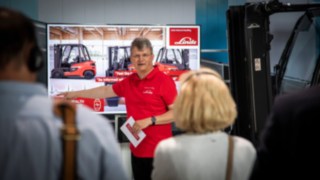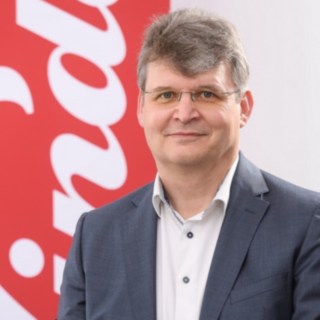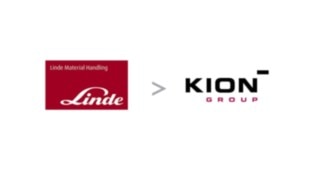Linde Brand Manager Stefan Prokosch looks ahead to the future of intralogistics
The Next Big Thing
How will the final transition from internal combustion trucks to electric trucks work? When will the large-scale use of hydrogen drives be possible? What role does digitalization play in intralogistics and what makes the digital twin a must-have for the future? Stefan Prokosch, Senior Vice President Brand Management at Linde, discusses all this and more in a wide-ranging interview focusing on the future.
Stefan, which vehicle has more potential for the future? The forklift truck or the car?
It is always said that logistics trucks lag around five years behind the automotive industry in terms of development. This may often be the case, but we are miles ahead in at least one key future issue: namely electrification. In Germany in particular, the electric revolution has only really taken hold in recent years. Here at Linde, we recognized the potential of electric drives over 50 years ago and have been consistently developing this technology since then. Today, around 60 percent of our forklift trucks and all of our warehouse handling trucks are powered by electricity. With our new counterbalanced forklift trucks, which were launched in 2021, we now even have an electric forklift truck, which can match the performance of a conventional internal combustion forklift in every regard.
So, does this spell the end for internal combustion trucks?
At Linde, we will continue to build IC trucks as long as our customers want them. But yes, in the medium term these models are on their way out. With reference to climate change, we owe it to future generations to move toward trucks with cleaner, environmentally friendly forms of energy. With our new counterbalanced trucks, we already have what is needed to switch from fossil fuel to electric. The basis for this is a shared technology platform on which we can build electric or IC trucks according to demand. We assemble them on the same line and use the same on-board architecture and software for both versions. This makes it as convenient as possible for our customers to switch from IC trucks to electric forklift trucks.
Here at Linde, we identified the potential for electric drives 50 years ago and have been consistently developing this technology ever since.
Do energy trends in intralogistics predict developments in the auto industry?
Yes, I certainly think that’s possible. A good candidate for that would be hydrogen propulsion, for example. At Linde, we have been developing and using this technology for many years. Many experts see hydrogen fuel cells as a long-term forward-thinking solution, both in intralogistics and in the automotive industry. And with good reason, as hydrogen holds huge potential. It could make us less dependent on raw material imports, while at the same time providing a truly environmentally friendly propulsion technology. That’s why more and more companies are starting to show a real interest in it.
What stage would you say hydrogen is currently at in terms of its development?
At the moment, hydrogen drives are still generally a niche solution, with limited potential for making money. The technology is mainly pushed by companies who either have access to hydrogen or are turning to hydrogen in order to offer their customers CO2-neutral products as quickly as possible. We want to assist them with this. We developed our first hydrogen forklift trucks together with Siemens 25 years ago. Today, we are able to offer our first series solutions for warehouse trucks. But we are also already looking to the future. Three years ago we began developing our own fuel cells, which are now almost ready for series production. I believe we are doing pioneering work here, with the potential to grow beyond our industry.
What would need to happen for hydrogen technology to be adopted across the board?
The technology is essentially already very widespread. That said, there is much still to be done. Each fuel cell is basically a miniature chemical plant. Widespread utilization raises many questions, which can only be solved by way of digitalization and standardization. For example, real-time data on pressure and tank temperature is required in order to calculate the ideal top-up speed and ensure effective refueling. This will not work if every manufacturer rigs up its own standalone solution. Similarly to electrification, hydrogen can only be successful if we create global standards and harness digitalization in a targeted manner.

With a digital twin, we can implement software updates “over the air,” enable new features and services at a later date, and perform remote diagnosis and predictive maintenance.
Stefan Prokosch, Senior Vice President Brand Management at Linde
As an engineer, do you think about the digital dimensions of a truck from the start?
Yes, we certainly do these days. As conventional truck manufacturers, we actually approach things from a hardware perspective, including when it comes to innovations. However, the digital world is becoming increasingly important in intralogistics, so we need to find out where we can support our customers’ processes digitally. At Linde, we have already done a lot to adopt this way of thinking. We now have more than a quarter of a million trucks in the field that can be integrated into digital warehouse environments. Around half of our new trucks can be networked when they leave the factory. At the same time, with our fleet management system Linde connect, we offer powerful software solutions, which we constantly upgrade with new features.
What is the next big thing in digitalization?
In my opinion, it will be the digital twin. This enables us to map the real truck in the virtual world, including all data from ongoing operations. We can then continually learn from the data, as long as the customers make it available to us, and have an accurate idea of the vehicle’s condition at all times. This way, we can tailor the truck to current requirements via software updates, without having to supply completely new hardware each time. So, the truck adapts to the challenges faced by our customers. At Linde, our latest trucks are already equipped with a digital twin. This means that we can implement software updates “over the air”, enable new features and services at a later date, and perform remote diagnosis and predictive maintenance. Digital twins are a useful tool for improving products and processes on an ongoing basis. We can also use them to monitor and optimize batteries and fuel cells.
In the future, climate protection and economic success will be two sides of the same coin. The key here is undoubtedly digitalization,
which brings us back to the topic of energy. What opportunities will digitalization open up as regards energy usage?
Huge opportunities. In light of current world events, we are facing a huge energy bottleneck in the medium term. Digitalization can help us to overcome this problem. Until now, manufacturers have mainly focused on reducing trucks’ consumption. But that’s no longer enough. One of the key issues for the future will be energy management. This involves questions such as: When can forklift trucks take a break to reduce consumption while maintaining the same turnover? How can I deploy my trucks in order to increase the efficiency of the fleet as a whole? What conclusions does the AI draw from the fleet usage in recent weeks? In the future, climate protection and economic success will be two sides of the same coin. The key here is undoubtedly digitalization,
